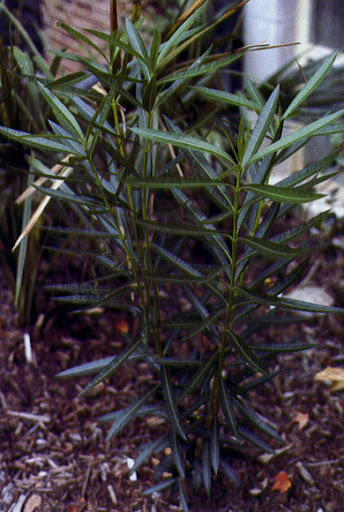Owszem są trujące, ale są piękne. O ile ktoś nie robi sobie sałatki z ich liści to nic nam się przecież nie stanie.

Jak mam ich mnóstwo od wielu lat i żyję.
Zaciekawił mnie natomiast bardzo ten oleander mający rosnąć w tym niemieckim miasteczku. Nawet podzieliłem się tą informacją z żoną, a ona powiedziała mi, że jak była kiedyś w okolicach Drezna, w miejscowości Pirna, widziała rosnącego oleandra.
Dzięki za ogimet Marcinie.
Zobaczmy jak to wygląda na mapie:

Z Drezna do Pirna jest 26.4 km.
Z Pirna do Batuzen jest 51.5 km.
Z Batuzen do Zgorzelca jest 50.5 km.
Odległości nie są jakieś specjalnie wielkie. Ciekawy jestem niezmiernie relacji aaartur'a07.
Warto zajrzeć jeszcze do literatury:
David A.
Francko, Palms Won't Grow Here and Other Myths: Warm-Climate Plants for Cooler Areas, s. 172
Nerium oleander, Oleander
While perusing my spring 2001 catalog from Plant Delights (Avent 2001) I was thrilled to note that the nursery is carrying cold-hardy varieties of oleander. This excellent, densely flowering evergreen shrub has generally been confined to zone 8 and warmer conditions in California and the southeastern and southwestern United States. When grown in zone 7, most of the more than four hundred Nerium oleander cultivars are killed back severely by normal winter weather. 'Hardy Double Yellow' and 'Hardy Pink' are rated only to zone 7b by Plant Delights, but the parent plants survived the -9°F (-23°C) deep freeze of 1984 in central North Carolina, and I suspect that this cultivar might perform well in good zone 6 sites. 'Hardy Double Yellow' reaches approximately 6 ft (1.8 m) in height and flowers profusely in late summer with masses of double yellow flowers. We installed several 1-ft (0.3-m) specimens in 2001, and by the end of the growing season they were 3 ft (0.9 m) tali (plate 38). Flowering was minimal in the summer of 2001. Most plants were killed nearly to the ground during that winter, but they have begun to regrow in spring 2002. A note of caution: all parts of oleander arę poisonous if ingested.
plate 38

Jak każda roślina oleander występuje w wielu odmianach. Franco pisze o czterystu. Większość z nich przeznaczona jest do strefy 8 oraz cieplejszej. Są i jednak odmiany, która mają sobie radzić w strefie 7b. Takimi odpornymi odmianami mają być
Hardy Double Yellow i
Hardy Pink. Oleandry tych odmian posadzone w strefie 6 miały przemarznąć do poziomu gruntu, ale jednak odbić.
Pamiętać oczywiście należy o ograniczeniach samej klasyfikacji USDA. Tym niemniej jest to bardzo ciekawe. Jak by taką odporną odmianę bardzo dobrze osłonić? Oleander to nie palma. Stożka wzrostu nie ma. Nawet jak jedna gałązka przemarznie to cała reszta może przetrwać.